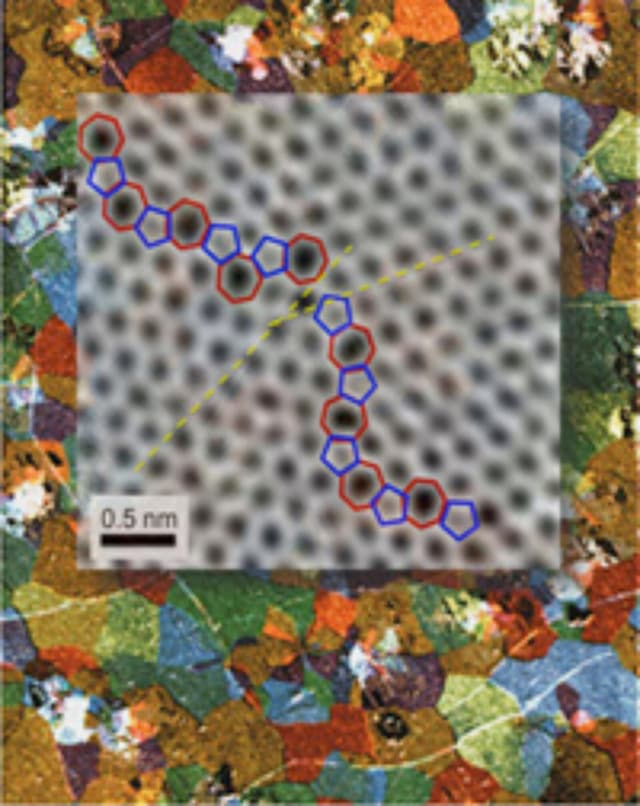Graphene Grains Make Atomic Patchwork Quilts

(Originally published by Cornell University)
January 5, 2011
A quick look at new Cornell research hints at colorful patchwork quilts, but they’re actually pictures of graphene – one atom-thick sheets of carbon stitched together at tilted interfaces. Researchers have unveiled striking, atomic-resolution details of what graphene “quilts” look like at the boundaries between patches, and have uncovered key insights into graphene’s electrical and mechanical properties.

The multidisciplinary Cornell collaboration, publishing online Jan. 5 in the journal Nature, focuses on graphene – a one atom-thick sheet of carbon atoms bonded in a crystal lattice like a honeycomb or chicken wire – because of its electrical properties and potential to improve anything from solar cells to cell phone screens. But it doesn’t grow in perfect sheets; rather, it develops in pieces that resemble patchwork quilts, where the honeycomb lattice meets up imperfectly and creates five- or seven-member carbon rings, rather than the perfect six. Where these “patches” meet are called grain boundaries, and scientists had wondered whether these boundaries would allow the special properties of a perfect graphene crystal to transfer to the much larger quilt-like structures.
To study the material, the researchers grew graphene membranes on a copper substrate (a method devised by another group) but then conceived a novel way to peel them off as free-standing, atom-thick films. Then, with diffraction imaging electron microscopy, they imaged the graphene by seeing how electrons bounced off at certain angles, and using a color to represent that angle. By overlaying different colors according to how the electrons bounced, they created an easy, efficient method of imaging the graphene grain boundaries according to their orientation. And as a bonus, their pictures took an artistic turn, reminding the scientists of patchwork quilts.
“You don’t want to look at the whole quilt by counting each thread,” said David Muller, professor of applied and engineering physics and co-director of the Kavli Institute at Cornell for Nanoscale Science, who conducted the work with Paul McEuen, professor of physics and director of the Kavli Institute; and Kavli member Jiwoong Park, assistant professor of chemistry and chemical biology. “You want to stand back and see what it looks like on the bed. And so we developed a method that filters out the crystal information in a way that you don’t have to count every atom.” This new method could apply to other two-dimensional materials, and sheds new light on the previously mysterious way that graphene was stitched together at grain boundaries.
Further analysis revealed that growing larger grains (bigger patches) didn’t improve the electrical conductivity of the graphene, as was previously thought by materials scientists. Rather, it is impurities that sneak into the sheets that make the electrical properties fluctuate. This insight will lead scientists closer to the best ways to grow and use graphene.
The work was supported by the National Science Foundation through the Cornell Center for Materials Research and the Nanoscale Science and Engineering Initiative. The paper’s other contributors were: Pinshane Huang, Carlos Ruiz-Vargas, Arend van der Zande, William Whitney, Mark Levendorf, Joshua Kevek, Shivank Garg, JonathanAlden, Caleb Hustedt and Ye Zhu. Original press release.